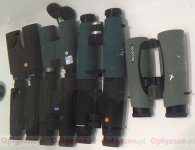Crud in new binoculars
Sometimes you can see finger prints and debris on Zeiss prisms and internal crud.
See 6m 27s for the reason why...
https://www.youtube.com/watch?v=q524cb2wFVQ
Look at the Fujifilm video on youtube at 3m 41s, the final lens assembly in Japan is done with everyone wearing gloves and facemasks and in a proper clean room.
Dirty Germans v clean conscientious Japanese basically !
https://www.youtube.com/watch?v=Iih0CP1H_Cw
Anyone got any links for Chinese binocular assembly lines like Nikon ?
Recently I inspected 3 x new Nikon Monarch 7 8x30 binos. Only a few speaks of dirt which were of no consequence, but the prism surfaces were not clean.
Sometimes you can see finger prints and debris on Zeiss prisms and internal crud.
See 6m 27s for the reason why...
https://www.youtube.com/watch?v=q524cb2wFVQ
Look at the Fujifilm video on youtube at 3m 41s, the final lens assembly in Japan is done with everyone wearing gloves and facemasks and in a proper clean room.
Dirty Germans v clean conscientious Japanese basically !
https://www.youtube.com/watch?v=Iih0CP1H_Cw
Anyone got any links for Chinese binocular assembly lines like Nikon ?
Recently I inspected 3 x new Nikon Monarch 7 8x30 binos. Only a few speaks of dirt which were of no consequence, but the prism surfaces were not clean.
Last edited:




